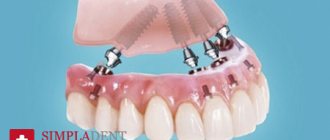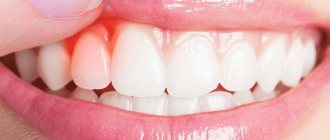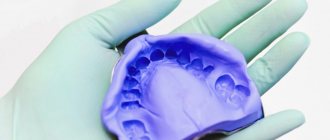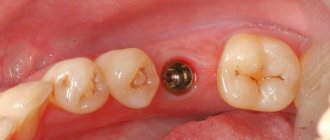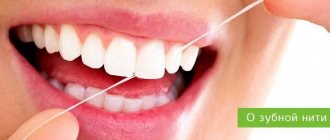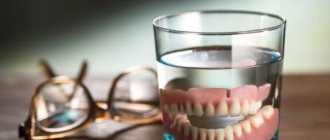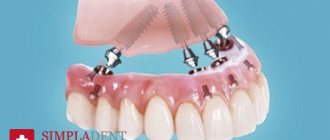Prosthetics allows you to restore the functionality and aesthetics of the dentition. After installing a fixed denture, patients experience a certain discomfort, which quickly passes, and the new teeth are quickly perceived as their own. With removable dentures, more serious problems arise, including a gag reflex and the inability to wear them every day.
Adaptation to dentures is an individual process: for some it takes only a few days, while for others it drags on for several months. We'll tell you how to quickly get used to dentures.
Dry mouth or increased salivation
A feeling of dryness or, on the contrary, increased salivation occurs due to the adaptation of the mucous membranes to a foreign body. If the design is made correctly, the discomfort quickly passes. If your mouth is dry, you should drink water more often and rinse, but do not use alcohol solutions. It is worth limiting the consumption of tea, coffee, and at least temporarily giving up smoking. You need to get rid of dryness quickly, otherwise your gums will be injured.
Excessive salivation is a reaction to a foreign body in the mouth, to constant contact with the mucous membrane. It goes away on its own in a few days. You can simplify the adaptation process for the mucous membrane by rinsing with decoctions of chamomile, oak bark or sage, or solutions recommended by your doctor.
Adaptation to dentures
On average, getting used to the prosthesis takes about 4 weeks. This period largely depends on the type of prosthesis. Thus, a plate product made of hard plastic provokes rubbing of the gums due to its rigidity and requires a long period of getting used to, up to 6 months. Acrylic and clasp dentures will require 2-3 months to get used to. Nylon constructions, quadrotti and acrifi have the shortest adaptation period of only 1-4 weeks.
The period of adaptation to the prosthesis occurs in 3 phases :
- Location phase (5 days). The prosthesis is perceived as a foreign body: it interferes with normal chewing of food and speaking. A lot of saliva is produced.
- Primary inhibition phase (5-7 days). The production of saliva is normalized, the lisp disappears, and discomfort remains when chewing food.
- Full braking phase. Discomfort is noted during removal of the prosthesis from the oral cavity.
It is possible to develop intolerance to orthodontic products with the following manifestations:
- burning, erythema in the mouth;
- soreness of the oral mucosa;
- loss of taste;
- metallic or plastic taste when eating.
This condition most often develops when there is an allergy to the materials from which the prosthesis or its components are made. This may also indicate that the prosthesis does not fit correctly.
Problems with diction
After prosthetics, there is less space in the mouth, which is why the patient may have problems with diction at first: the tongue does not have enough free space, sounds are distorted. To cope with this faster, you will need training. To do this, you can read aloud, pronounce individual complex sounds, and do tongue exercises. The more actively the tongue “works” immediately after prosthetics, the faster the adaptation will take place and normal diction will be restored. When getting used to speaking correctly, you need to make sure that when pronouncing sounds, saliva does not fly from your mouth. A good workout would be tongue twisters that are spoken slowly, making sure that the pronunciation and articulation are correct.
Caring for a removable denture
Proper care of the prosthesis is the key to the fastest possible adaptation. For those people who have previously carefully cared for their oral cavity and teeth, the process of caring for a denture will not become something scary and overly intrusive. You just need to learn a few simple rules:
- Rinse your mouth after every meal. It would also be a good idea to rinse the structure itself. Simply remove it from your mouth and rinse thoroughly under running water;
- Every morning, the denture must be cleaned with a brush and a special paste. Each type of prosthesis has its own accessories, which are selected separately. During the cleaning process, special attention should be paid to the inside of the prosthesis, this is where a huge number of different microorganisms accumulate, and food particles also become clogged. Otherwise, they can cause severe gum inflammation.
- Additional disinfection is still necessary. To carry it out, you will need to purchase some additional funds. In most cases, these are ointments or effervescent tablets, into the solution of which the prosthesis is dipped.
Some products for the care of dentures
Read about dental prosthetics in St. Petersburg in the article.
Moscow metro station Zvezdnaya, Danube Avenue, 23
Eating
Chewing skills with a newly installed denture need to be developed gradually. This does not mean that you need to switch to broths, purees and cereals. On the contrary, you need training with a gradual increase in load. The hardness of the products is increased gradually. It is better to start eating vegetables and fruits in small pieces, chewing them thoroughly. They get used to biting food in the same way - gradually, starting with softer foods and moving on to hard foods. You need to chew and bite carefully: it is important not to damage or injure the gums, and to control the load on it.
After installing a removable denture, the patient may feel that food is deprived of its usual taste, it has become less pronounced. This occurs because the base of the structure covers the palate where the tactile receptors are located. This does not affect the perception of taste in any way - taste buds are located on the tongue. The feeling that the taste of food has changed is associated with a foreign body in the mouth and quickly passes as you get used to it.
Do you have questions about removable dentures?
We will call you back within 30 seconds
+7
Terms of the adaptation period
In 90% of cases, patients feel discomfort after prosthetics. The time it takes to get used to dentures depends on many factors, so in some patients the discomfort goes away quickly, while in others it lasts for a long period.
It is difficult to talk about the exact timing of adaptation. Several criteria should be noted on which the adaptation time depends: the degree of fixation of the structure in the oral cavity, the condition of the patient’s periodontal tissues and his reactions to the denture material. The period of adaptation increases if the structure is not securely fixed in the oral cavity. Recovery time after prosthetics increases in patients who had periodontal damage at the time of the procedure.
A long period of adaptation is observed in people after the installation of bulge dentures. This is due to the fact that the design contains metal elements that have a negative effect on the soft tissues of the mouth.
How long does it take for addiction to occur? In many ways, the adaptation period also depends on the moral state of the patient. People who try to remove the system at every opportunity or experience psychological discomfort from wearing products are more likely to suffer from complications after prosthetics.
Let's consider other factors that prolong recovery time after prosthetics:
- Insufficient fixation of the product on the dentition.
- Thinning of the jaw structures, which develop due to a person’s long-term refusal to use prosthetics. Many people are in no hurry to immediately restore lost units and in the future face even greater problems with bite and atrophy of the bone structures of the jaw.
- Abnormal structure of the dental system.
- Inconsistency of artificial teeth in shape and size with the patient.
Injuries
In the first days after installation, injured areas may appear on the surface of the gums: small wounds, abrasions, etc. They may appear due to improper chewing technique or sensitivity of the mucous membrane. Normally, the denture stops rubbing the gums within a few days. You can speed up this process by rinsing with antiseptic solutions and chamomile decoction.
If injuries do not go away over time, become more pronounced, or cause increasing discomfort, you should consult a doctor. The problem may lie in the design itself. The doctor will conduct an examination and correct the prosthesis. Usually one correction is enough for the discomfort to go away.
Tips for getting used to it
Let's look at the basic recommendations that will help you quickly get used to removable dentures.
Normalization of chewing functions
In some patients, after prosthetics, the discomfort from eating food is so great that they completely refuse to eat or reduce their food intake as much as possible. This decision is not correct, since chewing loads reduce the time the body adapts to a foreign object.
To minimize discomfort, it is enough to refrain from chewing hard foods (pears, apples, cucumbers), which create a significant chewing load on the jaw bones. It is advisable to first cut solid food into small pieces or grind it in a blender. There is no need to give up fruits and vegetables during the rehabilitation period, because along with them valuable vitamins and microelements enter the body.
Clasp prosthesis for the lower jaw
The list of products whose consumption must be limited includes:
- crackers and stale bread;
- nuts;
- caramels;
- seeds;
- dried fruits.
Gum massage
Rapid blood circulation in the gums will reduce the duration of the adaptation period after prosthetics. Massage will speed up blood circulation in periodontal tissues. The procedure also relieves pain and discomfort while putting on structures.
The technique of gum massage is simple: the thumb is placed on the inner edge of the gum, and the index finger on the outer edge. Gently rub soft tissues with slight pressure on them. It is advisable to perform the procedure for 15 minutes a day.
Some toothbrushes (electric models) and irrigators are equipped with special attachments for the gums. Therefore, if you do not want to massage your gums with your hands, you can use devices. After the massage, the periodontal tissue will acquire a healthy appearance and elasticity.
Restoring diction with the help of special exercises
A common problem observed in patients after prosthetics is impaired speech functions. This especially confuses people whose professional activities involve speaking: consultants, teachers, announcers, TV presenters.
A set of exercises will allow you to quickly restore normal pronunciation of sounds; you only need to spend 15 minutes every day. To normalize speech, it is useful to pronounce words such as “arch”, “rainbow”, “wasp”, “nimble”, “good”. At first, reading words begins slowly, gradually accelerating the pace. In this case, the voice should be strengthened. Instead of the listed words, reading aloud your favorite book is suitable.
Another good way to get used to dentures is to read tongue twisters. If you regularly devote time to the procedure, diction will be restored within a week after prosthetics. Persistent problems with speech are a reason to contact an orthopedic dentist.
People who stop speaking after having prosthetics because of embarrassment are making a mistake. Enunciation exercises allow the body to quickly adapt to prostheses.
Normalization of the salivary glands
Due to the presence of a foreign object in the mouth, the salivary glands, as a rule, begin to secrete a large amount of secretion. This is especially true for the first days after the installation of dentures. This problem also leads to difficulty speaking and eating.
In some cases, dryness of the mucous membranes of the mouth may occur. Most often, the violation is observed after the installation of bulge dentures consisting of metal elements. Insufficient saliva production provokes a burning sensation in the mouth and threatens the rapid development of dental diseases.
To reduce secretion production, it is recommended to regularly rinse the mouth with saline or soda solutions (every 2 hours). To prepare the product 1 tsp. Stir without a slide in 150 ml of water. The effect after the procedure lasts for an hour.
You can eliminate dry mucous membranes by consuming a sufficient amount of liquid or mouth baths: a small amount of clean liquid is taken into the mouth and held for several minutes.
Fighting vomiting
If during the adaptation period the patient is bothered by the urge to vomit, it is recommended to breathe through the nose as often as possible and rinse the mouth with salt water. A gag reflex observed for several weeks is a reason to solve the problem of missing teeth using alternative methods.
Let's consider other ways to minimize an unpleasant symptom:
- distracting attention from discomfort by reading a favorite book or watching a TV show;
- sucking lollipops;
- doing what you love.
The duration of gagging observed after prosthetics largely depends on the structure and size of the structures.
Constantly wearing dentures
Usually, people remove removable structures at night and place them in a glass with a disinfectant solution. In order to shorten the period of adaptation, it is necessary to wear removable dentures constantly. At night, discomfort from the presence of products in the mouth does not arise due to the lack of chewing load on the jaws.
Restoring taste perception
Loss of taste in food is experienced by 30–35% of patients who have a prosthesis installed. The problem usually occurs when wearing bulky and cheap products that block the taste buds.
This problem is solved by influencing human psychology. It is not recommended to swallow food quickly; it is better to chew it gradually to restore taste sensations. At first, the procedure will not bring visible results, but after 2-3 weeks the taste buds will become more sensitive.
Allergic reaction
It occurs very rarely, since all structural elements are made of hypoallergenic, biocompatible materials. It manifests itself as redness of the gums at the contact site; this area may itch and possibly burn. The unpleasant sensations do not go away and do not weaken, they can intensify, the gums look injured.
Allergy is a rejection of construction materials, which may be accompanied by nausea, malaise, and dizziness. It appears almost immediately after installation, disappears after some time if you remove it. There is no point in waiting for adaptation in case of allergies - the reaction will only intensify over time. To solve the problem, you need to find out which material in the structure you are allergic to and make a new prosthesis without using it.
How to get rid of pain
It is important not to take independent action. Treatment of gum inflammation from dentures is carried out by a dentist, who first of all conducts an examination, identifies the cause of the pathology, and only then prescribes therapy and answers the question “how to treat.”
To cure the inflammatory process and eliminate pain caused by improper installation of the structure, correction of the prosthesis is undertaken. If the cause of the pathology is an allergic reaction to metal and its alloys, then there is only one way out - the manufacture and installation of a metal-free structure made of zirconium dioxide.
In a clinical setting, specialists treat and irrigate gums for regeneration and remove necrotizing tissue.
At home, patients use:
- Medications. The use of antibiotics and painkillers is prescribed by the dentist only if the gums under the dentures hurt as a result of complications.
- The most popular use of rinses, creams, gels and ointments, balms with anti-inflammatory, antimicrobial and antiseptic effects. The following popular brands accelerate the healing of gums - “Metragil-Denta”, “Miramistin”, “Cholisal”, “Forest Balsam”, “Malavit”, “Chlorhexidine”. Regular use and surface treatment helps relieve unpleasant symptoms and destroy bacteria accumulating under the structure.
- The use of special toothpastes (“Lakolyut”, “President”, “Parodontax”) helps reduce bleeding gums and relieve inflammation. The medicinal paste is used for a month. It is impossible to treat the gums after this time. You can add a drop of tea tree oil to a pea-sized amount of product. This is a natural antiseptic that is actively used in dentistry.
The application of collagen plates and pads under removable dentures is recommended by the doctor in case of constant friction. They perform the function of protecting the mucous membrane and disinfecting the surface. The plates are applied three times a day to the mucous membrane.
Psychological aspect
Often the use of a prosthesis provokes psychological discomfort in the patient: it frightens him, it seems to him that complications have already arisen, and adaptation is not going well. To prevent such a problem from arising, you need the right attitude: a person must be prepared for the difficulties that may arise in the first days. It is important to take your time and understand that the body needs to get used to new conditions. The period of complete adaptation takes up to one and a half months on average, but the most noticeable discomfort disappears after 1-2 weeks if you wear the prosthesis constantly.
To get used to a removable denture faster, orthodontists at the Dentospas clinic recommend massaging the gums. You can do it yourself, it will improve blood circulation and tissue nutrition, and improve the condition of the gums. Massage is done provided that the surface of the mucous membrane is not injured and there are no open wounds on it. At first, to speed up adaptation, you can leave the prosthesis on at night (install it again after cleaning). This is safe (the gums and tongue hardly move during sleep) and allows you to increase the time of contact of the mucous membrane with the base of the structure.
Why does discomfort occur?
A person with missing teeth gets used to living without them. His dental system begins to distribute the chewing load differently, and the muscles, cheeks, nerves, tongue and jaw bones involved in the process gradually get used to the restructuring that has occurred.
If missing teeth can be restored with permanent dentures, the parameters of which are almost identical to natural teeth, the load when chewing food turns out to be natural. And the absence of foreign elements - fixing hooks and staples - guarantees the absence of irritation of the mucous membranes of the cheeks and tongue.
In removable structures, the chewing load is distributed differently. For example, popular clasp dentures distribute it to the palate and the remaining adjacent teeth. It is clear that the sensations when chewing food will be unusual at first and will almost certainly cause irritation.
Complications of inflammation of the mucous membrane under the structure
If the patient ignores the listed symptoms and does not take measures to eliminate them, as a result, ulcers and foci of inflammation appear on the oral mucosa, in those places where there is contact with the prosthetic structure. Gradually they can atrophy, which will even cause necrosis (death) of the mucosa.
Before going to have the structure adjusted, the patient needs to put on the prosthesis and walk around with it for 3-4 hours. In this way, the orthopedic doctor will be able to mark a clear mark on the mucous membrane and correct exactly the place that leads to rubbing of the soft tissues.
Soreness
Most often, patients complain of pain and pressure on soft tissues. This phenomenon is observed when soft tissues are unaccustomed to stress and begin to hurt not only when chewing, but also at other times. Many people start taking painkillers as the only way to alleviate the condition. In addition to medications, which are needed only at first, it is recommended to change the diet and eliminate solid foods. It takes about a month to adapt, after which the pain stops bothering you. If the discomfort lasts longer, you should definitely see a doctor.
One option to reduce pain is gum massage. To do this, follow these simple steps:
- wash your hands with any soap with antibacterial properties;
- the prosthesis is removed, the gums should be stroked with gentle circular movements, gradually touching the inflamed area;
- the pressure gradually increases, you need to start making vertical movements.
The duration of exposure is three to four minutes, after which the pain decreases. It is recommended to do massage not only during the period of adaptation, but also constantly, improving blood circulation in the tissues, eliminating the risks of developing inflammation.
